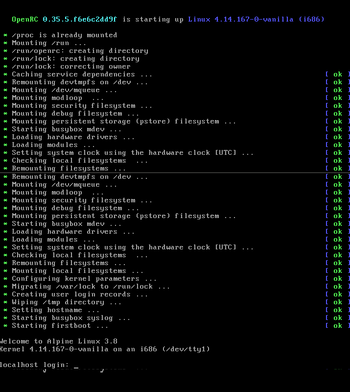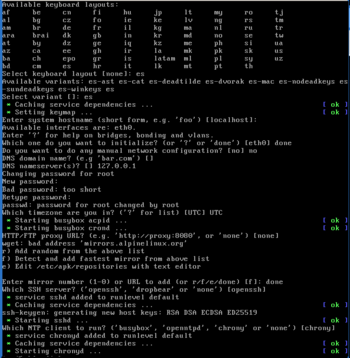Installation
Alpine Linux can be installed as the main operating system on a physical machine ("bare metal"), including on embedded devices. For example, PostmarketOS is a smartphone operating system based on Alpine, and Adélie Linux is a complete end-user distribution based on Alpine Linux. While this use is less common than Alpine Linux's main use as a base system for container images in systems like Docker, this document describes how Alpine can be installed as the primary operating system for a computer.
Alpine also works as a live system—Any install disk of Alpine can also be run without installing to local storage of the machine it's booted on, running directly from the install media!
Quick Requirements
Nearly any hardware should run Alpine Linux:
- At least 128MB of RAM for server without GUI, or at least 1.6GB for graphical desktop
- At least 1GB storage device for server without GUI, or at least 10GB for graphical desktop with web browsing
For more information, see Requirements.

Installation Overview
Those steps are brief and intended for the common case; for complete info and other architectures, please consult the Alpine newbie install manual.
1. Download the media source
Just grab an ISO from [1]. Take note of architectures in green buttons.
2. Dump, burn or flash the image
Dump the ISO image onto a media source like USB/SD flashing; or CD/DVD/BR disk with burning software.
In Linux, you can use dd to flash a USB drive or SD card:
dd if=<your iso> of=<your disk> bs=1M; sync
3. Boot and install process
Log in as the user root with its initially empty password. Then execute setup-alpine, answering the questions and hitting enter after each:

- Select keyboard layout: Let you to perform the keyborad layout, e.g. us or es
- Select keyboard variant: Choose your keyboard variant, e.g. us-nodeadkeys or es-winkeys respectively
- Host name, which will be the name of your computer; localhost are enough and recommended for starting.
- Initialize network cards: here most people can just go with the default (just press enter).
- Any other configuration: about any other configuration, just type "no" and hit enter
- Select domain name: if asked this are not commonly asked.. just hit enter.
- DNS nameservers?: if asked just type
8.8.8.8and hit enter. - Changing password for root: Next a root password must be defined, input a pass phrase, chars will not be show.
- retype password, input twice for confirmation, when typed no chars will be show.
- Which timezone to choose?: just hit enter to use
UTCwhen perform a single installation. - Proxy chooser: just type
noneand hit enter if you have direct internet connection. - Enter mirror repository: .. just type
1and then press enter - Which ssh server?: Choose an SSH server allows you to remotely manage your machine. Just type enter.
- Which NTP client to run? This is for time sync, just press enter to use default.
- Setup Disk This will setup the destination usage of the files
- Which disk choose to use?: To choose the disk destination .. commonly sda are the hard disk cos sdb the USB boot or CD/DVD image
- How would be used?: just type "sys" and then press enter, is the familiar install to disk for usage as main OS to computers.
Take care that all data on your disk will be erased.. a last question will prompt and by type "y" and hit enter no turn back will be allowed.
After all the scripts setup ends, a "reboot" will be offered:
- If the configured runtime mode was "sys", then remove the initial installation media to boot the newly installed system.
- If the configured runtime mode was "data", then keep installation media to boot the newly installed system.
The relevant commands for this are reboot or poweroff, after exits from setup-alpine process.
Further Documentation
After the system has been installed, it has only placed the operating system, but things like internet browser or movie viewer are not yet installed, things like web server or mail server neither much less. For that you must check Tutorials_and_Howtos Post-Install section
More specific or other architecture or machines (e.g. ARM, RPi, etc) are defined in Installation:_Use_cases wiki pages